Climate Adaptability Analysis of Traditional Dwellings in Mountain Terraced Areas: A Case Study of ‘Mushroom Houses’ in the Hani Terraces of Yunnan, China
Abstract
1. Introduction
2. Materials and Methods
2.1. Location
2.2. Research Methods
2.2.1. Meteorological Methods
2.2.2. Testing Methods
2.2.3. Questionnaire Survey
3. Results
3.1. Analysis of Outdoor Meteorological Factors
3.2. Analysis of Indoor Thermal Comfort in Traditional Dwellings
3.2.1. Thermal Neutrality
3.2.2. Thermal Acceptability Range
3.3. Analysis of Measured Indoor Climatic Factors in Traditional Dwellings
- (k is the globe constant)
- (hr, hc are radiative/convective coefficients)
3.3.1. Winter Measured Analysis
3.3.2. Summer Measured Analysis
4. Discussion
4.1. Building Orientation and Climate Adaptability
4.2. Building Function and Climate Adaptability
4.3. Building Form and Climate Adaptability
5. Conclusions
Author Contributions
Funding
Institutional Review Board Statement
Informed Consent Statement
Data Availability Statement
Acknowledgments
Conflicts of Interest
References
- Yang, Z.; Solangi, Y.A. Analyzing the relationship between natural resource management, environmental protection, and agricultural economics for sustainable development in China. J. Clean. Prod. 2024, 450, 141862. [Google Scholar] [CrossRef]
- Aguilar, A.J.; Ruiz, D.P.; Martínez-Aires, M.D.; Torres, M.L.d.l.H. Indoor Environment in Educational Buildings: Assessing Natural Ventilation. In Building Engineering Facing the Challenges of the 21st Century; Bienvenido-Huertas, D., Durán-Álvarez, J., Eds.; Springer: Singapore, 2023; Volume 345, pp. 441–458. [Google Scholar]
- Fei, T.; Liu, Y.; Guo, J. Visual Integration Relationship between Buildings and the Natural Environment Based on Eye Movement. Buildings 2022, 12, 930. [Google Scholar] [CrossRef]
- Rahim, M.; Munir, A.; Marasabessy, F.; Darmawijaya. Local Wisdom and Sustainable Features of Tidore Vernacular Architecture. Civ. Eng. Archit. 2023, 11, 531–549. [Google Scholar] [CrossRef]
- Majumder, A.; Debsarkar, A. Assessment of multi-dimensional sustainability of vernacular architecture from global perspective: A critical review over the period (2000–2023). Res. J. Chem. Environ. 2024, 28, 101–122. [Google Scholar] [CrossRef]
- Wu, Y.; Gong, G.; Yu, C.W.F.; Fang, P. The hygroscopic properties of wood fibre, sepiolite and expanded perlite-based breathable wall for moderating the humidity environment. Indoor Built Environ. 2013, 23, 299–312. [Google Scholar] [CrossRef]
- Ornam, K.; Wonorahardjo, S.; Triyadi, S. Several façade types for mitigating urban heat island intensity. Build. Environ. 2023, 248, 111031. [Google Scholar] [CrossRef]
- Houghton, A. Climate action should learn from building design. BMJ 2023, 383, 2910. [Google Scholar] [CrossRef]
- Shilar, F.A.; Ganachari, S.V.; Patil, V.B. Advancement of nano-based construction materials-A review. Constr. Build. Mater. 2022, 359, 129535. [Google Scholar] [CrossRef]
- Moscoso-García, P.; Quesada-Molina, F. Analysis of Passive Strategies in Traditional Vernacular Architecture. Buildings 2023, 13, 1984. [Google Scholar] [CrossRef]
- Tarigan, R. Modernity vs Traditionality: The Approach the Vernacular Architecture in Maintaining Traditional Architecture through Structuralism. J. Archit. Hum. Exp. 2023, 1, 1–10. [Google Scholar] [CrossRef]
- Savaşkan, M.O.; Özener, O.Ö. H-BIM applications for vernacular architecture: A historic rural house case study in Bursa, Turkey. Eng. Constr. Archit. Manag. 2023, 30, 3997–4017. [Google Scholar] [CrossRef]
- Yu, S.; Hao, S.; Mu, J.; Tian, D.; Zhao, M. Research on Optimization of the Thermal Performance of Composite Rammed Earth Construction. Energies 2022, 15, 1519. [Google Scholar] [CrossRef]
- Chen, M.; Wang, H.; Hu, Z.; Zhou, Q.; Zhao, L. Heritage Regeneration Models for Traditional Courtyard Houses in a Northern Chinese City (Jinan) in the Context of Urban Renewal. Sustainability 2024, 16, 8089. [Google Scholar] [CrossRef]
- Soszyński, D.; Kociuba, P.; Tucki, A. Sustainable Spatial Development of Multifunctional Villages: A Case Study of Eastern Poland. Sustainability 2024, 16, 7965. [Google Scholar] [CrossRef]
- Joensuu, T.; Leino, R.; Heinonen, J.; Saari, A. Developing Buildings’ Life Cycle Assessment in Circular Economy-Comparing methods for assessing carbon footprint of reusable components. Sustain. Cities Soc. 2022, 77, 103499. [Google Scholar] [CrossRef]
- Chen, Q.; Wen, Y.; Zhang, X.; Zhu, Z. Evolutionary Overview of Terrace Research Based on Bibliometric Analysis in Web of Science from 1991 to 2020. Int. J. Environ. Res. Public Health 2022, 19, 7796. [Google Scholar] [CrossRef]
- Gravagnuolo, A.; Varotto, M. Terraced Landscapes Regeneration in the Perspective of the Circular Economy. Sustainability 2021, 13, 4347. [Google Scholar] [CrossRef]
- Liu, D.L.; Liu, J.P.; Yang, L. Building Climatic Classification in China. Adv. Mater. Res. 2011, 374–377, 365–368. [Google Scholar] [CrossRef]
- Yang, X.; Zhao, Y.; Zhao, J.; Shi, C.; Deng, B. Tourists’ Perceived Attitudes toward the Famous Terraced Agricultural Cultural Heritage Landscape in China. Agriculture 2022, 12, 1394. [Google Scholar] [CrossRef]
- The Weather Company. The Weather Channel. 2024. Available online: https://weather.com/zh-CN/weather/today/l/CHXX0008:1:CH?Goto=Redirected (accessed on 9 May 2025).
- Lu, Z.; Hauschild, M.; Ottosen, L.M.; Ambaye, T.G.; Zerbino, P.; Aloini, D.; Lima, A.T. Climate mitigation potential of biobased insulation materials: A comprehensive review and categorization. J. Clean. Prod. 2024, 470, 143356. [Google Scholar] [CrossRef]
- State General Administration of the People’s Republic of China for Quality Supervision and Inspection and Quarantine. Evaluation Standard for Indoor Thermal Environment in Civil Buildings; The Ministry of Housing and Urban-Rural Development of the People’s Republic of China & State General Administration of the People’s Republic of China for Quality Supervision and Inspection and Quarantine: Beijing, China, 2012.
- ISO 7730:2005; Ergonomics of the Thermal Environment—Analytical Determination and Interpretation of Thermal Comfort Using Calculation of the PMV and PPD Indices and Local Thermal Comfort Criteria. ISO: Geneva, Switzerland, 2005.
- ASHRAE 55; Thermal Environmental Conditions for Human Occupancy. ASHRAE: Peachtree Corners, GA, USA, 2017.
- Lin, Y.; Huang, T.; Yang, W.; Hu, X.; Li, C. A Review on the Impact of Outdoor Environment on Indoor Thermal Environment. Buildings 2023, 13, 2600. [Google Scholar] [CrossRef]
- Momenifar, S.; Chen, Y.; Hamzeh, F. A Hybrid Decision Support System for Partition Walls. Buildings 2024, 14, 2738. [Google Scholar] [CrossRef]
- Cascone, S.; Parisi, G.; Caponetto, R. BIM-Based Strategies for the Revitalization and Automated Management of Buildings: A Case Study. Sustainability 2024, 16, 6720. [Google Scholar] [CrossRef]
- Mao, Y.; Lu, H.; Xiao, Y.; Lai, Z.; Huang, L. A Parametric HBIM Approach for Preservation of Bai Ethnic Traditional Timber Dwellings in Yunnan, China. Buildings 2024, 14, 1960. [Google Scholar] [CrossRef]
- Aguilar-Sanchez, M.; Almodovar-Melendo, J.-M.; Cabeza-Lainez, J. Thermal Performance Assessment of Burkina Faso’s Housing Typologies. Buildings 2023, 13, 2719. [Google Scholar] [CrossRef]
- Alfano, F.R.d.A.; Dell’Isola, M.; Ficco, G.; Palella, B.I.; Riccio, G. Small globes and pocket heat stress meters for WBGT and PHS evaluations. A critical analysis under controlled conditions. Build. Environ. 2022, 226, 109781. [Google Scholar] [CrossRef]
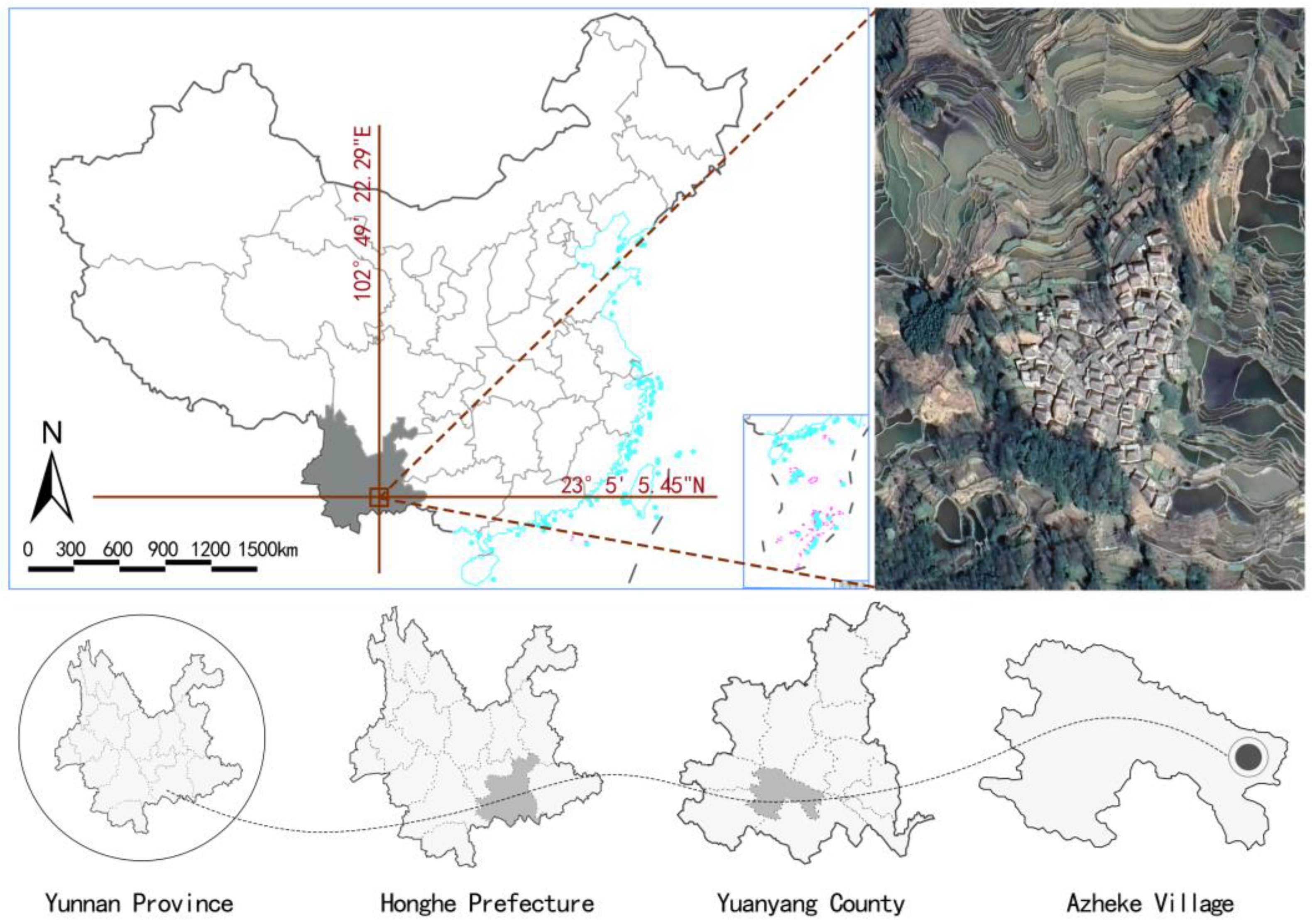
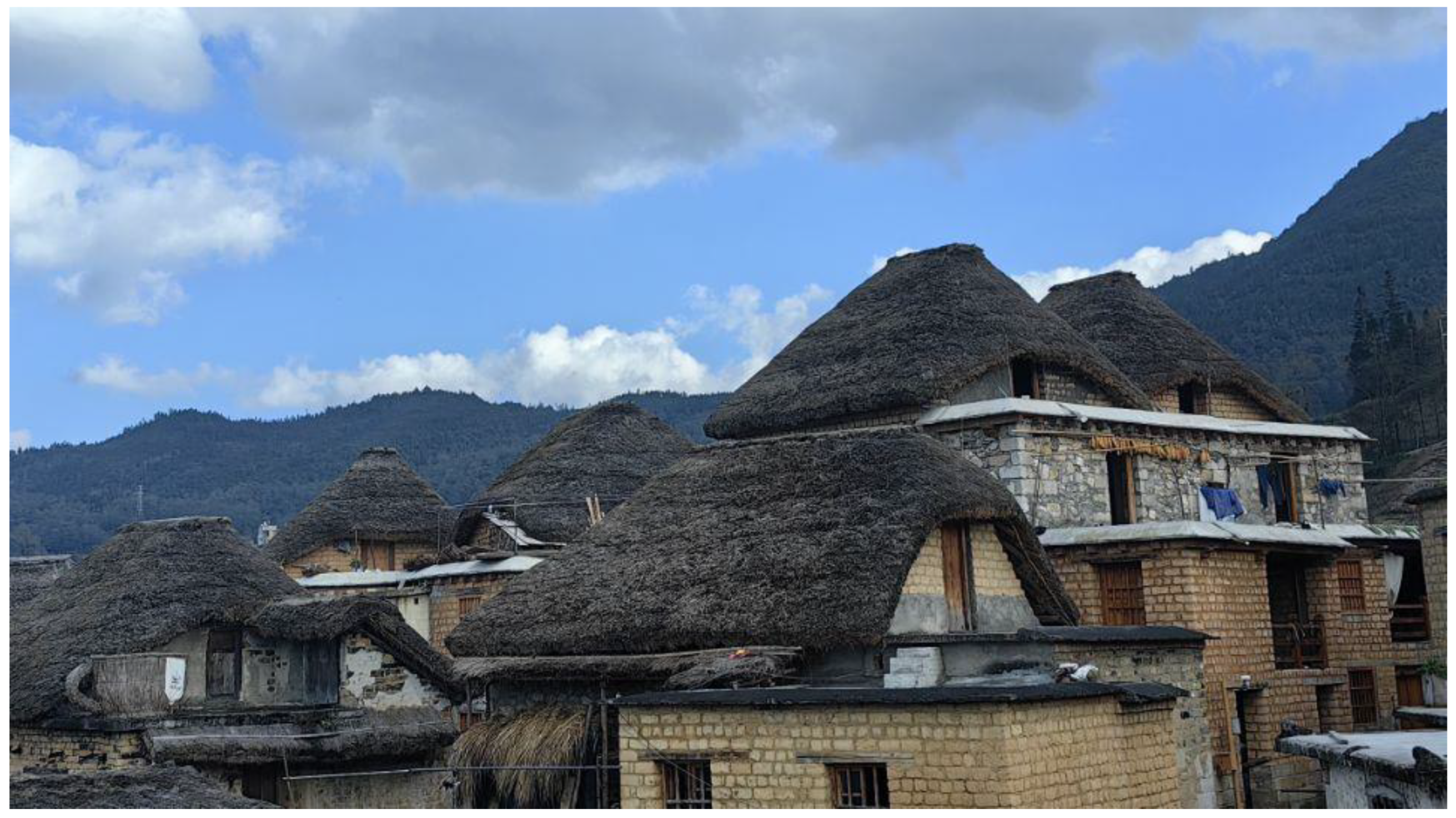
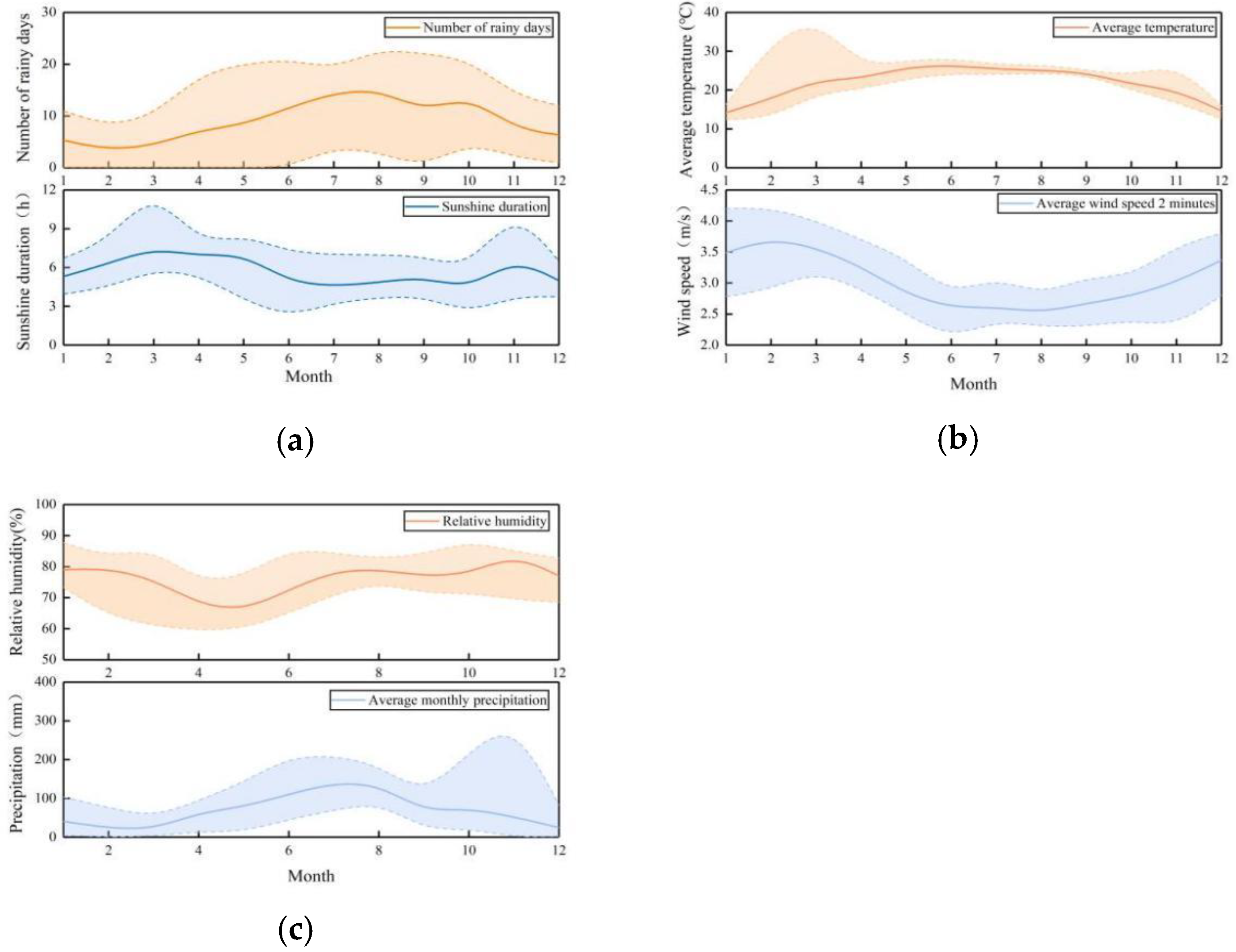
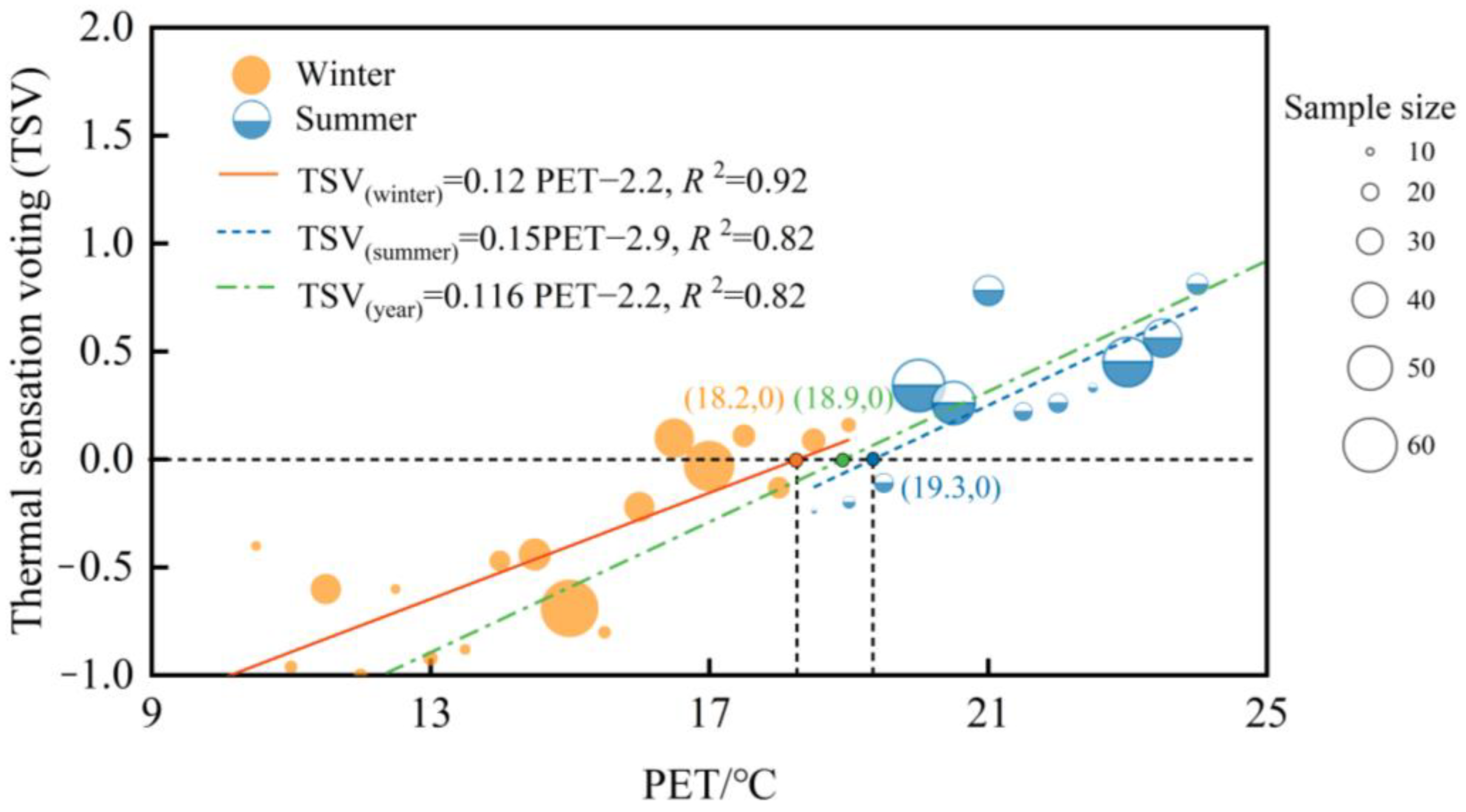

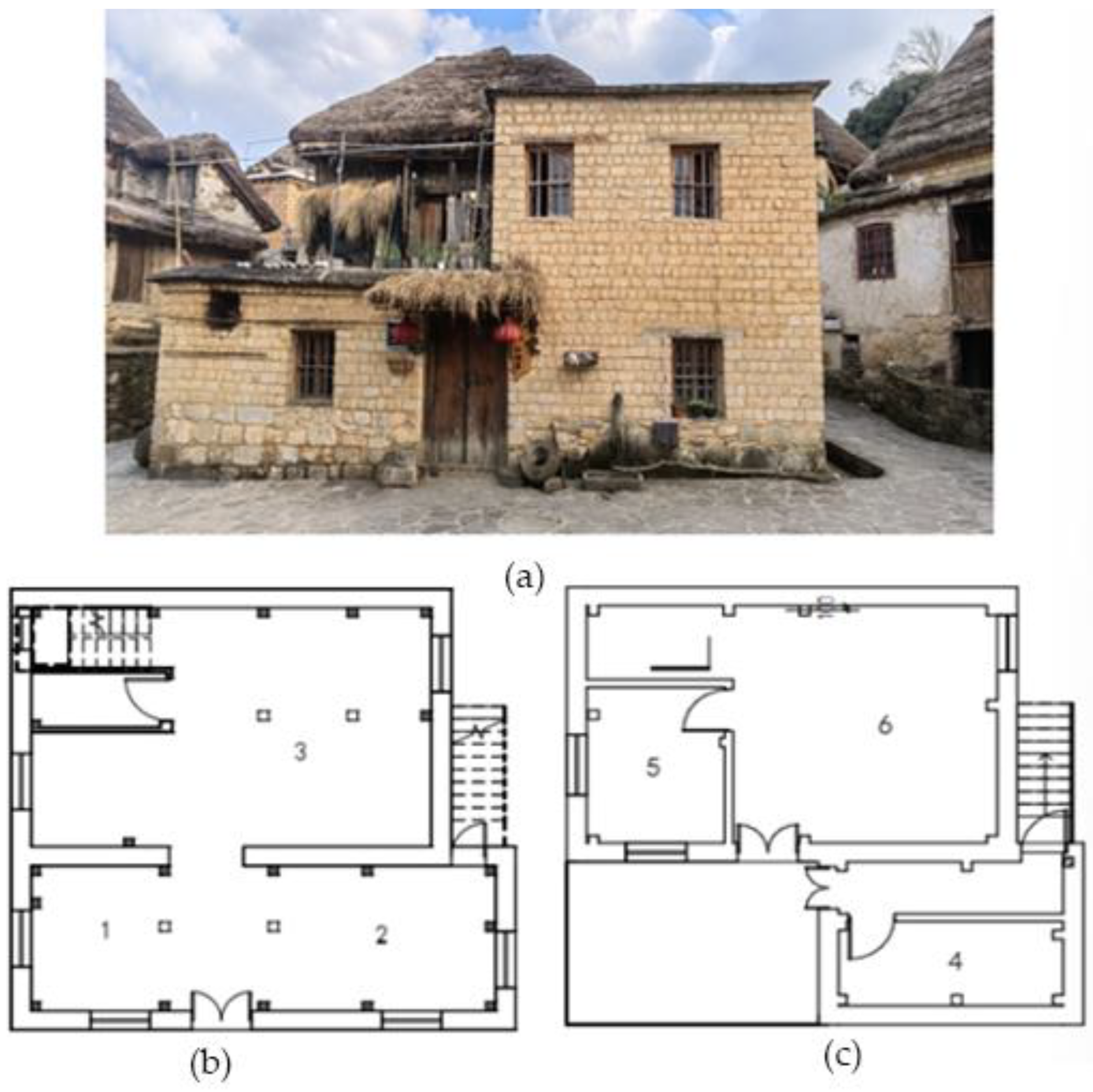
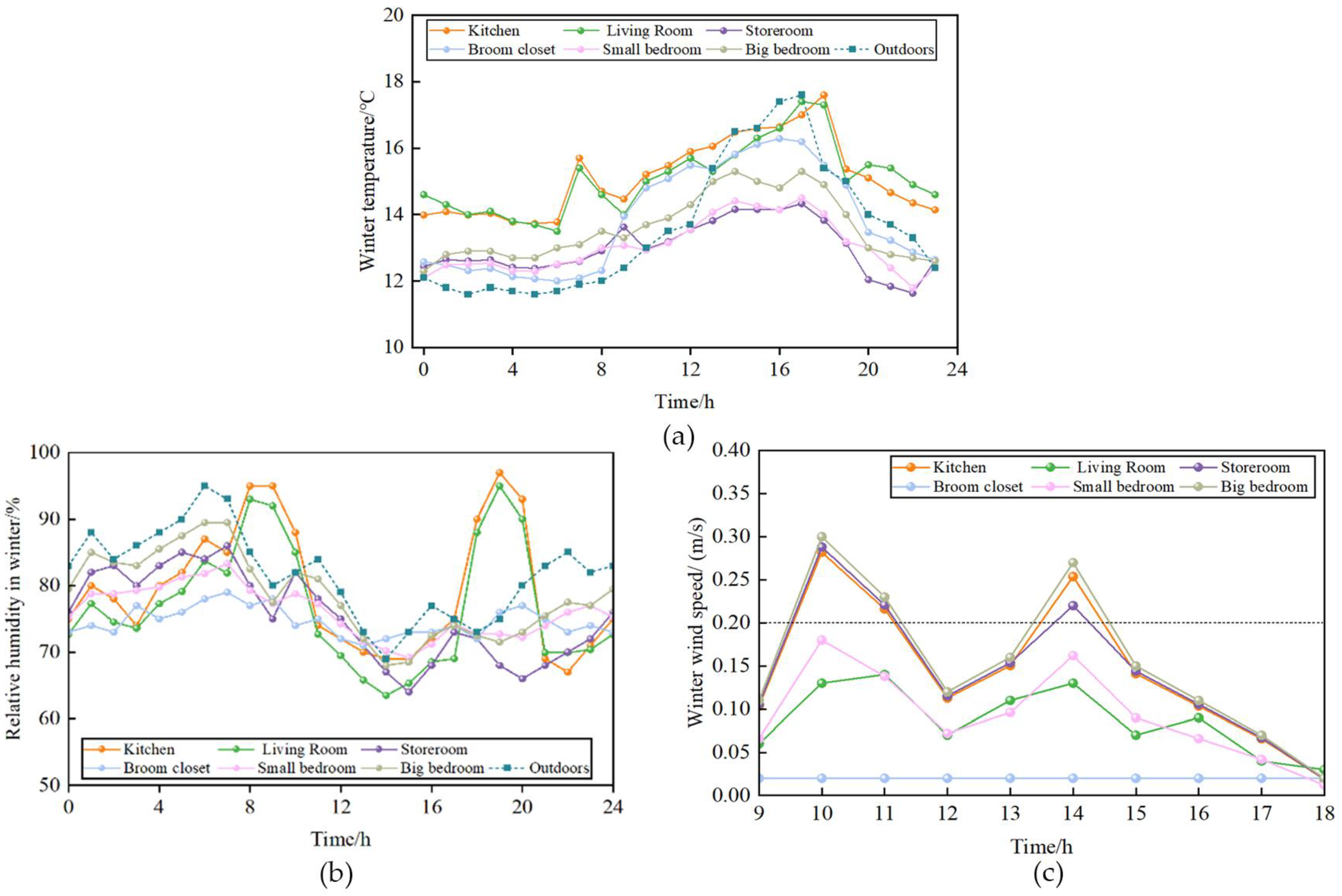
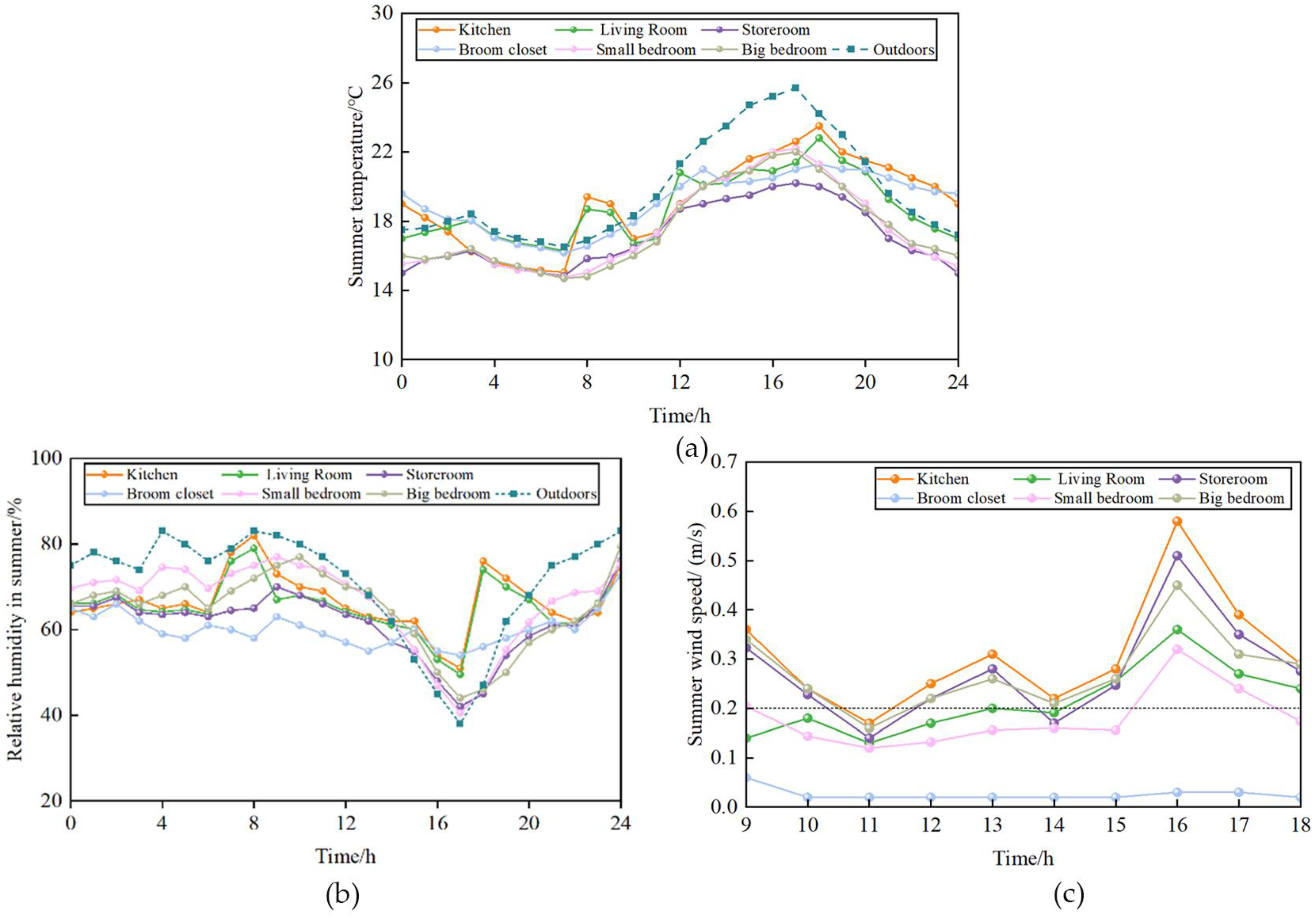

| Year | Season | Month | Date | Test Time |
|---|---|---|---|---|
| 2023 | Summer (Rainy Season) | May | 2nd–6th | 9:00 a.m.–18:00 p.m. |
| 2023 | Winter (Dry Season) | December | 10th–14th | 9:00 a.m.–18:00 p.m. |
| Testing Instrument | Test Parameter | Measuring Range | Instrument Accuracy |
|---|---|---|---|
| RaytekRaynegr wall thermometer | Wall temperature | −15–535 °C | ±(0.2 °C + 1% measurement value) |
| Pioneer | Indoor wind speed | 0.00–40.00 | ±(3% + 0.03 m/s) |
| Luger LK-99LXWS | Indoor air humidity | 0–1 RH | ±2–3% RH |
| AM-101 | Mean radiation temperature | 0–50 °C | --- |
| Indoor PMV index | −3–+3 | --- | |
| Indoor PPD index | 0–100% | --- |
| Year | Season | Month | Date | Survey Time |
|---|---|---|---|---|
| 2023 | Summer (Rainy Season) | May | 2nd–3rd | 9:00 a.m.–12:00 a.m. 13:00 p.m.–17:00 p.m. |
| 2023 | Winter (Dry Season) | December | 10th–11th | 9:00 a.m.–12:00 a.m. 13:00 p.m.–17:00 p.m. |
| Climate-Regulating Space | Primary Strategy | Secondary Strategy | Passive Mechanism | Figure Reference |
|---|---|---|---|---|
| First Floor Storage Room | Vertical Ventilation | Thermal Mass Buffering | Humidity Control |  |
| Heated Kang | Radiant Heating | Thermal Storage | Smoke Ventilation | 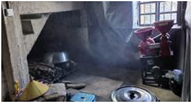 |
| Central Atrium | Stack Effect Ventilation | Daylight Harvesting | Thermal Buffer Zone | 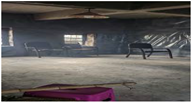 |
| Balcony | Solar Shading | Cross Ventilation | Rainwater Diversion |  |
| Climate-Regulating Element | Primary Strategy | Secondary Strategy | Passive Mechanism | Figure Reference |
|---|---|---|---|---|
| Thatched Roof | Thermal Buffering | Solar Radiation Reflection | Evaporative Cooling | 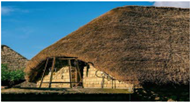 |
| Elevated Shanty | Solar Shading | Underfloor Ventilation | Rainwater Drainage |  |
| Perforated Corridor | Cross Ventilation | Daylight Modulation | Thermal Mass Effect |  |
| Wall Ventilation Openings | Stack Ventilation | Night Purge Cooling | Insect Screening |  |
Disclaimer/Publisher’s Note: The statements, opinions and data contained in all publications are solely those of the individual author(s) and contributor(s) and not of MDPI and/or the editor(s). MDPI and/or the editor(s) disclaim responsibility for any injury to people or property resulting from any ideas, methods, instructions or products referred to in the content. |
© 2025 by the authors. Licensee MDPI, Basel, Switzerland. This article is an open access article distributed under the terms and conditions of the Creative Commons Attribution (CC BY) license (https://creativecommons.org/licenses/by/4.0/).
Share and Cite
Hu, L.; Liu, Y.; Li, X.; Yan, P. Climate Adaptability Analysis of Traditional Dwellings in Mountain Terraced Areas: A Case Study of ‘Mushroom Houses’ in the Hani Terraces of Yunnan, China. Atmosphere 2025, 16, 608. https://doi.org/10.3390/atmos16050608
Hu L, Liu Y, Li X, Yan P. Climate Adaptability Analysis of Traditional Dwellings in Mountain Terraced Areas: A Case Study of ‘Mushroom Houses’ in the Hani Terraces of Yunnan, China. Atmosphere. 2025; 16(5):608. https://doi.org/10.3390/atmos16050608
Chicago/Turabian StyleHu, Luyao, Yinong Liu, Xinkai Li, and Pengbo Yan. 2025. "Climate Adaptability Analysis of Traditional Dwellings in Mountain Terraced Areas: A Case Study of ‘Mushroom Houses’ in the Hani Terraces of Yunnan, China" Atmosphere 16, no. 5: 608. https://doi.org/10.3390/atmos16050608
APA StyleHu, L., Liu, Y., Li, X., & Yan, P. (2025). Climate Adaptability Analysis of Traditional Dwellings in Mountain Terraced Areas: A Case Study of ‘Mushroom Houses’ in the Hani Terraces of Yunnan, China. Atmosphere, 16(5), 608. https://doi.org/10.3390/atmos16050608







